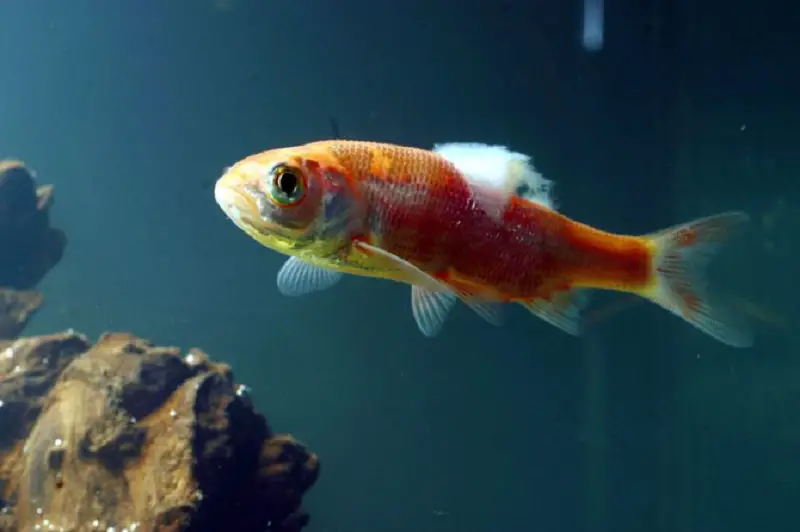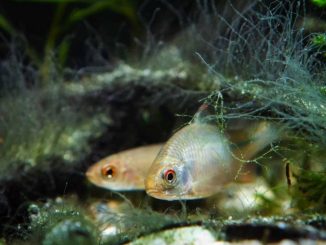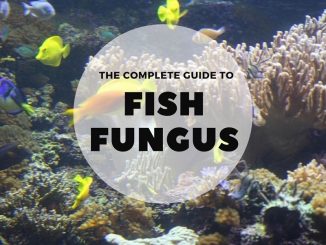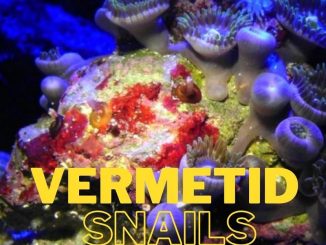
Ornamental fish, the fish you keep as pets in an aquarium, are prone to disease no matter how careful you are in your efforts to keep them healthy.
Fish are not as easy to care for as you might imagine. Raising fish is not about just feeding them, changing the water, and watching them swim. It’s true that fish don’t need walks and training like dogs, and don’t need large living spaces like horses, but they still need quite a lot of conscientious care.
Some of the factors that cause fish to get sick include overcrowding in the tank, poor water conditions, poor nutrition, and stress caused by extreme heat or cold, or aggressive behavior of other fish.
There are three types of diseases pet fish can develop – bacterial diseases, viral diseases, and fungal diseases. Different fish are more prone to certain conditions than others, and the symptoms and treatment are specific to each different disease. If you are an observant pet owner and can recognize the first changes in your fish’s appearance or behavior, you have a good chance of treating and curing the disease before it leads to death.
A number of the more common fish diseases are discussed below.
Bacterial/Parasite Diseases

Cotton Mouth (Columnaris)
- Symptoms: Small areas on the fish’s head and around its mouth turn pale, and the greyish white or white spots start to appear. Eventually, the larger patches can become brownish-yellow with red-tinged edges
- Treatment: Siphon the tank’s gravel and change 30% to 50% of the water. Remove the carbon from the filter, and then treat with aquarium salt, Melafix, Furan 2, or an antibiotic prescribed by a vet. Replace the carbon only after treatment is complete. This is an extremely contagious condition and often leads to death.
Dropsy
- Symptoms: The fish’s abdomen swells and the scales protrude, due to a buildup of fluid. The fish will stop eating and appear listless. This is a bacterial infection of the kidneys.
- Treatment: Quarantine the fish and feed it high-quality food, and maintain very clean water in its tank. Prognosis is usually death.
- Symptoms: White spots all over the fish, making it look like it was sprinkled with salt. This may affect several or all of your fish because the parasite reproduces veraciously in the aquarium water. Your fish may appear lethargic or move their gills rapidly. They may rub against the sides of the tank, or sit motionless at the bottom.
- Treatment: Treating this parasite takes time and must be thorough to completely clear it out of your aquarium. Over 24 hours, gradually increase the water temperature to 29°C. Remove the carbon from your filter. Maintaining that temperature, use drops specifically for curing ich, following the directions on the packaging. Only replace the carbon when treatment is complete.
Slime disease
- Symptoms: The fish becomes covered with a grey-white to blue layer of mucus. The fish will also breathe rapidly. If this parasitic slime continues to accumulate, the fish can die of suffocation.
- Treatment: This condition is caused by stress, brought on by overcrowding, sudden changes in the water temperature, or dirty water. Change 30% to 50% of the water. Remove the carbon from the filter, and then treat with aquarium salt (use carefully), Melafix, or Furan 2. Replace the carbon only after treatment is complete.
Chilodonella
- Symptoms: The fish’s skin will excrete an excess of mucus that gives it a cloudy color. The fish will also display a loss of appetite, labored breathing, and rubbing itself against objects in the aquarium.
- Treatment: Special medication to treat Chilodonella can be added to the water. The fish can be bathed – in a separate tank from healthy fish – in salt, copper, malachite, formalin, or potassium permanganate.
Viral Diseases

Hemorrhagic septicemia
- Symptoms: The fish’s skin, muscles, and/or internal organs start to hemorrhage. The fish’s eyes, fins, gills, and skin will have a blue to red bruised appearance. In more severe cases the fish will have bulging eyes and open lesions.
- Treatment: While the prognosis for fish with this virus is usually death, some fish can be saved by changing the tank water, removing the carbon from the filter, and using antibiotics to treat secondary infections.
Lymphocystis
- Symptoms: The fish begins to develop small white growths on its skin or fins that look like miniature cauliflower heads. While these growths are unattractive, they are not life-threatening. If growths appear on the fish’s gills or fins they can impair breathing and swimming.
- Treatments: Unfortunately, there is no treatment for this disease. However, it will sometimes clear up by itself if you maintain optimal water quality and temperature and feed your fish the food they require. Warm water fish can be cured in two to three weeks, while it takes as long as six weeks for cool water fish to overcome this condition.
Fungal Diseases

Every fish tank harbors fungal spores, but if they multiply to dangerous levels the fish will become stressed or sick. Fungal infections usually attack fish with weakened immune systems. There are four basic fungus treatments for fish: Malachite green, Acriflavine, Methylene blue, and salt.
Cotton Fin Fungus/Cotton Wool Disease
- Symptoms: White growths on the fin, gills, mouth, or skin, with a cotton-like appearance.
- Treatment: Quarantine the fish and then siphon the tank’s gravel and change 30% to 50% of the water. Add aquarium salt or an anti-fungal product to the water.
Stress/Diet Related Conditions
Fin/Tail Rot
- Symptoms: The fish’s tail or fins start rotting, with white or frayed edges. The fish may stop eating and remain at the bottom of the tank.
- Treatment: The fish has probably been bullied, and needs to be placed in quarantine. Siphon the gravel and make sure the water is very clean. then treat with Melafix, Furan 2, or an antibiotic prescribed by a vet.
Hole in the Head
- Symptoms: Tiny pits or “holes’ appear on the fish’s head.
- Treatment: Change 30% to 50% of the water, and carefully monitor the water temperature and PH levels. Make sure the fish receives high-quality flakes with sufficient vitamins for its specific needs.
Other problems fish can suffer from include: Popeye (a buildup of fluid behind the eyes), Swim Bladder Disorder (impaired swimming and floating), Velvet (rusty, gold, or yellow spots caused by a parasite), Anchor Worms (greenish-white protruding lines on the fish’s skin), Clamped Fin (fins held close to the body), and many other mites, ticks and worms that can infect aquarium fish.
Each condition requires a specific treatment, and it’s always a good idea to consult with a vet or at least the store that sold you your fish, before starting any treatment.
When treating fish with medications, try not to overfeed them. If they are always hungry there is a better chance they will ingest enough of the medication to start to heal.
Read Related Topic: The Complete Guide to Fish Fungus
Which fish are most prone to disease?
While all fish can contract almost all fish diseases, some fish are more prone to suffering from certain conditions than others.
Fish without scales, such as Eels, Catfish, and Loaches, as well as silver-scaled fish such as Hatchet Fish, Bala Sharks, and Silver Dollars, are particularly susceptible to ich.
Young fish and Discus are susceptible to Chilodonella.
Severums, Discus, Angelfish, and Discus are susceptible to Hole in the Head, also known as Lateral Line Disease.
Goldfish and Koi are susceptible to viral infections.
Which Fish Can Help Keep your Tank Disease Free?

In the human world, we have garbage collectors to take away our refuse and thus help prevent disease. We also have scientists in charge of discovering how to decrease air and water pollution, in hopes a cleaner world will be a healthier world to live in.
Nature has lots of built-in mechanisms for cleaning up debris and refuse. The water in fast running streams and rivers “cleans itself” when sediment gets caught on underwater vegetation, and the sun is a natural decontaminant.
In a home aquarium, there is no water flow – you are solely responsible for changing the water and keeping it fresh and clean. Also, exposing your aquarium to direct sunlight is actually detrimental to fish health, because it can heat the water to dangerously high temperatures.
However, nature has provided us with certain fish that can help you keep your aquarium clean, and thereby prevent disease among their tank-mates. Pleco fish, the Siamese Algae Eater fish, and Amano Shrimp work to eat leftover food in the tank substrate.
The Pleco fish – the full name is Plecostomus – is commonly called the Sucking Catfish. This fish should be purchased when still small enough to swim comfortably in your tank because they can eventually grow to a length of 50 centimeters (20 inches). If you want to own a Pleco, you will need a very large tank. Even though there are smaller types of Plecos, such as the Bristelnose and Rubber-lip, which only reach seven inches longs as adults, even the smaller types need at least a thirty-gallon tank.
This fish is a nocturnal omnivore. While you and the fish in your tank sleep at night, the Pleco will swim around the bottom of the tank sucking up food refuse and algae. If you have a good imagination, you can think of this fish as a waterproof vacuum cleaner for your tank.
Since they are not aggressive fish, Plecos will peacefully live side by side in an aquarium with fish that are smaller than they are. Good tank mates for Plecos include other catfish species, Angel Fish, Betas, Hatchets, Guppies, Mollies, and Loaches.
The Siamese Algae Eater grows to a length of six inches and therefore also needs a large tank to live in. This fish eats algae and leftover food and plant matter and is even a better tank cleaner than the Pleco.
Though it is not an aggressive fish and can live peacefully with most other types of fish, two Siamese Algae Eaters in the same tank can be problematic. This fish can get territorial, not understanding that there is probably plenty of food for two garbage collectors. If you want two of these fish, your tank should hold at least 55 gallons of water.
Amano Shrimp are not actually fish. They are crustaceans that happily climb up and down your aquarium plants acting as gardeners to devour any plant material that is starting to decay. They also scavenge for leftover food and algae on the tank floor. These are small creatures that may look like tasty snacks for larger fish. So if you want Amano Shrimp in your aquarium, only follow through on that decision if your fish a small and do will living in “mixed communities”.
General Tips for Preventing Disease in your Fish

- Make sure the filter you install in your tank is the proper size for the volume of water it is cleaning, and test and change the tank water regularly.
- Invest in a good thermometer to help you ensure there are no extreme temperature changes in the tank water.
- Whenever you handle the filter, or clean the tank, or immerse your hands in the tank water, wear rubber gloves. Make sure not to let anything that was in the aquarium come in contact with anything else in your home.
- Put the tank light on a timer to turn it off at night, so you won’t have to worry about accidentally leaving it on.
- Carefully examine the skin, fins, tail, and gills of the fish you are considering to buy. Watch them swim and eat, and take note of any worrying behavior.
- Whenever you bring new fish home, keep it in a separate tank from the other fish – under “quarantine” – until you are sure it is disease-free and won’t infect your other fish. The optimal time frame is 30 days.
- Have separate nets and other equipment for the display aquarium and the quarantine aquarium.
- When feeding your fish live food, prevent parasite infestation by only using foods you produced yourself, or food raised in water that is fish free.
- After feeding, use a net to remove any leftover food from the water’s surface. Old food can rot and create a perfect habitat for viruses and bacteria to grow.
Euthanizing Ill Fish
No matter how much you love your fish, and how determined you are to cure them of their diseases, sometimes the wisest choice is to put an ill fish out of its suffering.
This isn’t just a matter of protecting a sick fish from further discomfort or pain, but it’s about protecting the rest of the fish in the aquarium. Many fish diseases are difficult and time-consuming to cure, and some are almost impossible to cure in the first place. In certain instances, keeping a sick fish in the aquarium jeopardizes the health of your other fish.
After a discussion with your vet or an expert on raising ornamental fish, you may decide that one of your fish – or all the fish in your aquarium – should be killed. However, most fish lovers won’t feel comfortable just flushing a sick fish down the toilet, or throwing it in the garbage. There are several ways you can kindly help your fish “cross over to the other side” without causing it any additional suffering.
Clove Oil
Clove oil is a natural sedative that can be purchased without a veterinarian prescription. You will need 400 mg of clove oil per liter of water. First, mix the oil with a small amount of warm water to dilute it, and then add it to the tank water gradually. It should take you about five minutes to add the entire amount.
After exposure to the clove oil in their tank, fish will soon lose consciousness, and die of hypoxia (they stop breathing). Leave the fish in the water for a least 10 minutes to be sure they are really dead.
Anesthesia Overdose
If you are squeamish about euthanizing your fish, you can ask your vet to administer anesthesia in a controlled manner. It will cost you money, but you won’t have any guilty feelings about personally killing your pet.
Never kill your sick fish by cutting off its head, putting it in ice to freeze it, or dropping it alive in boiling water. All of these methods are considered to be cruel as death is not instant.
Never throw the dead fish in the garbage or flush it down the toilet, or dispose of it in natural bodies of water. Those methods of disposal can potentially spread the very disease your fish suffered from. In the United States, flushing fish down the toilet is in fact illegal!
The best method of disposal is to wrap the fish in biodegradable material (paper or cotton cloth) and bury it in the dirt. American Indians used the fish as fertilizer for the crops. Burying your dead fish in your home garden is a humane and ecological method of disposal.








I have a molly who suddenly has the texture of a pruney finger. Any ideas?
I have 1 Discus out of 9, that has lost interest in food, reluctant to swim, faces back wall. All other 8 eat aggressively. I water change weekly, temp @ 82F, varied diet, she was breeding regularly now that has also stopped. Any Ideas?